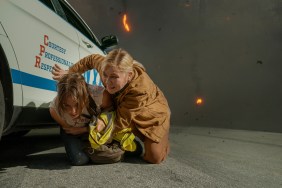
My first experience with the work of Roberto Rossellini was when I reviewed Criterion’s Il Generale Della Rovere back in March 2009 (read that here). Less than a month after that I watched the first film in Rossellini’s War Trilogy, Rome Open City, for the first time via a Netflix rental. The film was excellent with specific moments of true terror as citizens of Rome struggle against the occupying Germans during World War II. However, the DVD transfer was awful and had I been reviewing it I never would have recommended it. So to say I was anxiously waiting to see what Criterion would deliver with their three-DVD release of Roberto Rossellini’s War Trilogy would be an understatement, but once again Criterion manages to impress beyond expectations.
All three films in this set — Rome Open City, Paisan and Germany Year Zero — look spectacular and prove the very existence of Criterion is supremely important in ensuring important films such as these are not lost to second rate DVD releases using duplicates and shoddy prints. Of course there is something to be said for the fact Rossellini had to make due with what he could find at the time and had to use mismatched film stock to finish his features, but Criterion details Paisan, for example, which required over 500 hours of work and more than 265,000 individual manual fixes to get it to where it is for this release. Impressed? As for Germany Year Zero, the version included here is the original version with German opening titles and its complete and correct original-language soundtrack — the dubbed and alternate Italian opening is included as a supplemental feature.
This doesn’t mean these transfers are perfect, mind you, and just as well they really shouldn’t be if we are talking about matching up with the way they looked in their original presentation. Paisan, obviously from what I noted above, is still the film in the roughest state of affairs, but its newsreel-esque approach benefits from the status of the print. Each film has also been picture-boxed by placing a black border around all sides of the 1.33:1 aspect ratio to ensure as much information can be presented on all sides of the image.
As for the films, it’s difficult to connect to them on a historical level as their importance when released cannot be fully realized 65 years later, but one can easily find value in all three films. Just consider the fact we are talking about an Italian filmmaker who began work on Rome Open City two months after the Allies forced the Germans out of Rome and the film itself was released 25 days after the formal surrender of Japan. You want relevant? It doesn’t get much more relevant than that and Rossellini’s realistic approach to filmmaking only makes it that much better.
Rome Open City is widely considered the best film of the trilogy and majority opinion is that it is Rossellini’s best film altogether. It is looked at as defining the neorealist film movement as Rossellini often used non-professional actors, location shooting, natural light and more importantly a documentary-like presentation. Throughout the three films in this trilogy much of that is evident, more so in some than others. Rome Open City uses a pair of known Italian stars in Aldo Fabrizi and Anna Magnani, but to United States audiences their involvement didn’t have the same impact, and the film was impactful as it told the story of the Nazi occupation of Rome and those laboring against the regime.
Paisan is a much different film, as I said, taking the newsreel approach to a most literal level presenting six separate stories with voice over narration leading off each accompanied by stock war footage before getting into each individual narrative. Rome Open City is viewed as the story of a city with Paisan looked at as the story of the country as the six stories make their way from the south up to the north with an emphasis on Allied involvement in Italy.
Both Paisan and especially Rome Open City travel down some dark paths, but I wasn’t at all prepared for Germany Year Zero, a film that is over before you know it with a running time of only 73 minutes. However, at its conclusion it leaves you in a heap and staring at the screen in awe. The film is set in post-war Berlin and follows Edmund, a 12-year-old German boy having to do whatever he can to help his family following the fall of the Third Reich. His father is sick in bed, his sister is currently doing everything other than prostitution to earn money and his brother does nothing — hiding at home for fear of what will come to him should people learn he fought to the bitter end for Hitler. While many consider Rome Open City to be Rossellini’s masterpiece, I don’t think it comes close to standing up to the devastation and observation of human frailty as does Germany Year Zero. This film floored me.
This set doesn’t stop at just the films though. All three discs include a series of special features, most of which are absolute must watch fare and once you start watching them you won’t want to stop. My only advice is to be sure you have watched all three films before doing so as some are prone to spoil each film, in particular Germany Year Zero, something I have seen several reviewers doing recently as well.
Among my personal favorites are the three-part interview features on each disc with Rossellini historian Adriano Apra, a 2001 documentary on Rossellini, which includes comments from the likes of Martin Scorsese and Francois Truffaut and an interview with critic and Rossellini friend Father Virgilio Fantuzzi discussing Rossellini and the role of religion in Rome Open City.
The most interesting feature, though, was the illustrated essay “Roberto and Roswitha” by film scholar Thomas Meder discussing Rossellini’s four-year relationship with his mistress Roswitha Schmidt and how it may have influenced his films, most notably Germany Year Zero. It’s the only time I can remember reading a DVD video essay the entire way through, but then again I was enthralled by every entry in this collection. I can only imagine what territory these features will tread once Criterion begins releasing the Rossellini films starring his most famous of mistresses… Ingrid Bergman.
The set is capped off by a 44-page booklet, which includes essays by James Quandt, Irene Bignardi, Colin MacCabe and Jonathan Rosenbaum.
I am typically cautious when recommending Criterion titles, because I know they are expensive and I believe it is important to be mindful of that when telling someone something is an absolute must buy. However, with this collection there is no hesitation. I can’t imagine how this release will not be looked back at as one of the ten best releases of 2010 and we are only 26 days into the new year.










